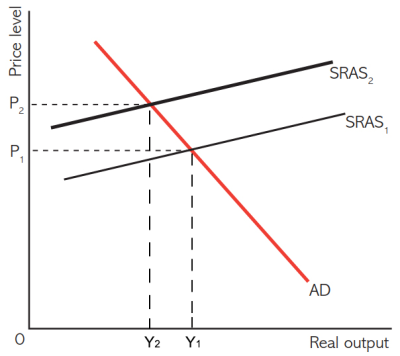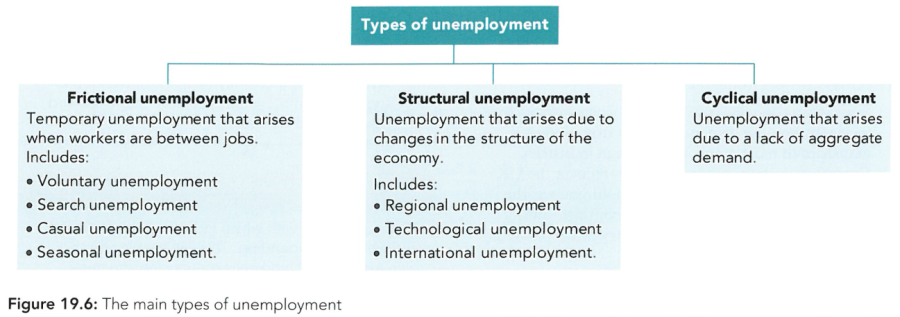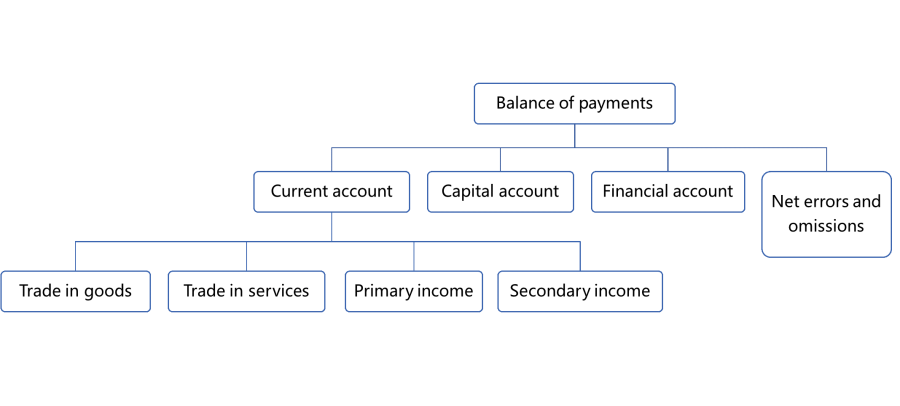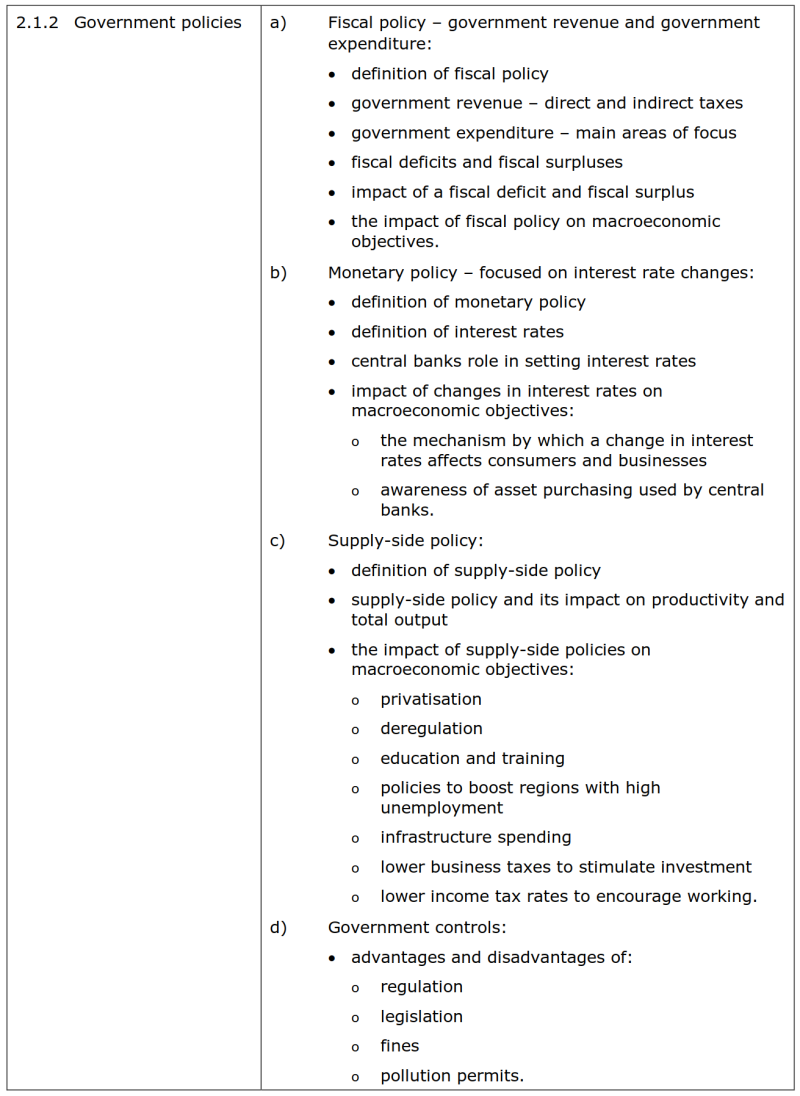“Edexcel IG revision - 2.1 (2019)”的版本间的差异
| 第20行: | 第20行: | ||
• the effect of each stage of the economic cycle on economic growth, inflation and unemployment<br/> | • the effect of each stage of the economic cycle on economic growth, inflation and unemployment<br/> | ||
• the impact of economic growth on:<br/> | • the impact of economic growth on:<br/> | ||
o employment<br/> | |||
o standards of living<br/> | |||
o poverty<br/> | |||
o productive potential<br/> | |||
o inflation<br/> | |||
o the environment.<br/>}} | |||
<br/> | <br/> | ||
*经济增长的定义与分类: | *经济增长的定义与分类: | ||
| 第75行: | 第75行: | ||
• measurement using consumer price index (CPI)<br/> | • measurement using consumer price index (CPI)<br/> | ||
• types of inflation:<br/> | • types of inflation:<br/> | ||
o demand pull<br/> | |||
o cost push.<br/> | |||
• relationship between inflation and interest rates<br/> | • relationship between inflation and interest rates<br/> | ||
• impact of inflation on:<br/> | • impact of inflation on:<br/> | ||
o prices<br/> | |||
o wages<br/> | |||
o exports<br/> | |||
o unemployment<br/> | |||
o menu costs<br/> | |||
o shoe leather costs<br/> | |||
o uncertainty<br/> | |||
o business and consumer confidence<br/> | |||
o investment.<br/>}} | |||
<br/> | <br/> | ||
*Inflation:通货膨胀。指的是价格水平price level的持续上升(通常为两个季度),通胀率为正数。此时货币的购买力下降。 | *Inflation:通货膨胀。指的是价格水平price level的持续上升(通常为两个季度),通胀率为正数。此时货币的购买力下降。 | ||
| 第141行: | 第141行: | ||
• measurement of unemployment using International Labour Organization (ILO) measure<br/> | • measurement of unemployment using International Labour Organization (ILO) measure<br/> | ||
• types of unemployment:<br/> | • types of unemployment:<br/> | ||
o cyclical<br/> | |||
o structural<br/> | |||
o seasonal<br/> | |||
o voluntary<br/> | |||
o frictional.<br/>}} | |||
• impact of unemployment on: | • impact of unemployment on: | ||
o output | |||
o use of scarce resources | |||
o poverty | |||
o government spending on benefits | |||
o tax revenue | |||
o consumer confidence | |||
o business confidence | |||
o society. | |||
<br/> | <br/> | ||
*经济学中的失业unemployment指的是有能力able、愿意工作willing to work、却没有工作without jobs的人。 | *经济学中的失业unemployment指的是有能力able、愿意工作willing to work、却没有工作without jobs的人。 | ||
| 第213行: | 第213行: | ||
• examples of real-world exchange rates<br/> | • examples of real-world exchange rates<br/> | ||
• reasons for deficits and surpluses:<br/> | • reasons for deficits and surpluses:<br/> | ||
o quality of domestic goods<br/> | |||
o quality of foreign goods<br/> | |||
o price of domestic goods<br/> | |||
o price of foreign goods<br/> | |||
o exchange rates between countries.<br/> | |||
• impact of current account deficit:<br/> | • impact of current account deficit:<br/> | ||
o leakage from the economy<br/> | |||
o can be inflationary if prices rise abroad<br/> | |||
o low demand for our exports<br/> | |||
o problems finding foreign reserves to fund the deficit.<br/>}} | |||
<br/> | <br/> | ||
*The balance of payments(BOP):国际收支账户。本国与外国发生的贸易和资金往来,都会记录在该账户下。 | *The balance of payments(BOP):国际收支账户。本国与外国发生的贸易和资金往来,都会记录在该账户下。 | ||
| 第264行: | 第264行: | ||
• business activity that damages the environment<br/> | • business activity that damages the environment<br/> | ||
• ways businesses damage the environment:<br/> | • ways businesses damage the environment:<br/> | ||
o visual pollution, including litter<br/> | |||
o noise pollution<br/> | |||
o air pollution<br/> | |||
o water pollution.<br/> | |||
• government intervention to protect the environment:<br/> | • government intervention to protect the environment:<br/> | ||
o taxation<br/> | |||
o subsidy<br/> | |||
o regulation<br/> | |||
o fines<br/> | |||
o pollution permits<br/> | |||
o government provision of parks.<br/>}} | |||
<br/> | <br/> | ||
*损害环境的企业行为: | *损害环境的企业行为: | ||
| 第304行: | 第304行: | ||
• definition of relative poverty<br/> | • definition of relative poverty<br/> | ||
• reasons to reduce poverty and inequality:<br/> | • reasons to reduce poverty and inequality:<br/> | ||
o meet basic needs<br/> | |||
o raise standards of living<br/> | |||
o ethical reasons.<br/> | |||
• government intervention to reduce inequality and poverty:<br/> | • government intervention to reduce inequality and poverty:<br/> | ||
o progressive taxation<br/> | |||
o redistribution through benefit payments<br/> | |||
o investment in education and healthcare.<br/>}} | |||
<br/> | <br/> | ||
*Income inequality:收入不平等,指社会群体之间的收入不相同。 | *Income inequality:收入不平等,指社会群体之间的收入不相同。 | ||
| 第402行: | 第402行: | ||
• central banks role in setting interest rates<br/> | • central banks role in setting interest rates<br/> | ||
• impact of changes in interest rates on macroeconomic objectives:<br/> | • impact of changes in interest rates on macroeconomic objectives:<br/> | ||
o the mechanism by which a change in interest rates affects consumers and businesses<br/> | |||
o awareness of asset purchasing used by central banks.<br/>}} | |||
<br/> | <br/> | ||
*Monetary policy:货币政策。央行通过调节利率interest rates、货币供给money supply等来改变总需求aggregate demand的各类政策。 | *Monetary policy:货币政策。央行通过调节利率interest rates、货币供给money supply等来改变总需求aggregate demand的各类政策。 | ||
| 第441行: | 第441行: | ||
• supply-side policy and its impact on productivity and total output<br/> | • supply-side policy and its impact on productivity and total output<br/> | ||
• the impact of supply-side policies on macroeconomic objectives:<br/> | • the impact of supply-side policies on macroeconomic objectives:<br/> | ||
o privatisation<br/> | |||
o deregulation<br/> | |||
o education and training<br/> | |||
o policies to boost regions with high unemployment<br/> | |||
o infrastructure spending<br/> | |||
o lower business taxes to stimulate investment<br/> | |||
o lower income tax rates to encourage working.<br/>}} | |||
<br/> | <br/> | ||
*supply-side policy:供给侧政策。政府通过培训training、基础设施发展infrastructure development、支持技术提升support for technological improvement等多种方式提升Long-run aggregate supply(LRAS)长期总供给,增加经济体的生产潜力productive potential和产能productive capacity。 | *supply-side policy:供给侧政策。政府通过培训training、基础设施发展infrastructure development、支持技术提升support for technological improvement等多种方式提升Long-run aggregate supply(LRAS)长期总供给,增加经济体的生产潜力productive potential和产能productive capacity。 | ||
| 第473行: | 第473行: | ||
{{color|grey| | {{color|grey| | ||
• advantages and disadvantages of:<br/> | • advantages and disadvantages of:<br/> | ||
o regulation<br/> | |||
o legislation<br/> | |||
o fines<br/> | |||
o pollution permits.<br/>}} | |||
<br/> | <br/> | ||
*常见的government control政府管控措施: | *常见的government control政府管控措施: | ||
2023年7月11日 (二) 00:53的最新版本
如遇到公式加载异常,请刷新页面!
2.1 Government and the economy 政府与经济
2.1.1 Macroeconomic objectives 宏观经济目标
- 大纲要求
a) Economic growth: 经济增长
• definition of economic growth
• measurement using increases in gross domestic product (GDP)
• limitations of GDP as a measure of growth
• the use of diagrams to show the economic cycle: annotating boom, downturn, recession and recovery
• the effect of each stage of the economic cycle on economic growth, inflation and unemployment
• the impact of economic growth on:
o employment
o standards of living
o poverty
o productive potential
o inflation
o the environment.
- 经济增长的定义与分类:
- Actual economic growth实际经济增长:GDP国内生产总值的增长。
- 注意:经济增长可采用GDP等指标的变化率进行衡量。
- 注意:经济增长率\(economic\space growth\space rate = \frac{GDP_{2}-GDP_{1}}{GDP_{1}}\)
- Potential economic growth潜在经济增长:productive potential生产潜力上升(也称为最大产出上限提升)
- Actual economic growth实际经济增长:GDP国内生产总值的增长。
- Gross Domestic Product (GDP):国内商品与服务的总产出。以国界线作为划分标准,无论是本国企业还是外国企业,只要在本国国界范围内,都计入GDP。
- 使用GDP衡量经济增长的问题:
- 如果使用普通的名义GDP来衡量经济增长,会受到inflation通货膨胀的影响,改用实际GDP来衡量更加合理。
- 受到population change人口变化的影响,改用人均GDP来衡量更加合理。
- 存在statistical errors统计错误的可能,数据不一定完全准确。
- 存在hidden economy隐藏经济,统计局无法对其进行计量(统计数字小于现实数字)
- low levels of literacy识字率低。难以正确报告相关数字。
- non-material goods and services非物质商品和服务的存在。这些难以准确估价,也难以买卖,因此GDP的计算中大多数时候并没有考虑它们。比如志愿者服务、家庭主妇的劳动成果等。
- GDP数字的增长可能建立在pollution污染和depletion of non-renewable resources消耗不可再生资源的基础上,不能sustainable development可持续发展。
- GDP数字的增长可能建立在labour exploitation剥削劳动力或使用child labour童工的基础上,违反法律和道德。
- 使用GDP衡量经济增长的问题:
- phases of the cycle经济周期的阶段:分为以下四大阶段,如图所示。

- Upturn上升阶段:又称expansion或 (economic) boom。该阶段经济持续上升,消费者和生产者都非常乐观,就业增加,消费和投资旺盛。
- 如果该上升阶段中,real GDP尚小于trend real GDP,该阶段也可以称之为recovery恢复阶段,即从经济萧条中恢复的时期。
- Peak顶峰阶段:经济发展到了该时期的最高峰,也是经济由盛转衰的转折点。此时经济增长带来的负面影响比较显著,如高通胀、positive output gap正产出缺口等。
- Downturn下行阶段:又称recession衰退。该阶段经济增长率下滑,消费者和生产者变得悲观,开始着手规避风险,如减少投资和增加存款。
- Trough探底阶段:经济发展到了该时期的最低谷,总需求严重不足,但随着经济自身纠正或政府干预,经济会逐渐扭转颓势,进入下一轮的upturn阶段。这是经济由衰转盛的转折点。
- 经济可能会发展到depression萧条期,此时real GDP大幅下降,就连potential GDP也可能因为企业难以完成补充上折旧要求的capital数量(保持原产量所必须进行的更新换代成本)而导致产量下降。
- Upturn上升阶段:又称expansion或 (economic) boom。该阶段经济持续上升,消费者和生产者都非常乐观,就业增加,消费和投资旺盛。
- 经济周期与inflation通胀、unemployment失业之间的关系:
- 当经济的实际产出real GDP>trend real GDP时,此时经济处于蓬勃发展阶段,经济增长迅速,失业率较低,通胀比较严重。
- 当经济的实际产出real GDP<trend real GDP时,此时经济处于衰退或恢复阶段,经济负增长,失业率较高,可能出现通缩。

- 经济增长的影响:
- Employment就业方面:经济增长会带来更多岗位和工作,提升就业。
- standards of living生活水平方面:经济增长能够增加更多商品和服务的提供,提升就业,增加收入,提高教育与医疗水平,改善人们的生活质量。
- poverty贫困方面:经济增长能够减少贫困。
- productive potential生产潜力方面:长期经济增长能够提升一个国家的生产上限,增加产能。
- inflation通胀方面:经济增长会带来较为严重的通货膨胀。
- the environment环境方面:一方面,经济增长能够提升处理污染物的技术水平,提升对资源的使用效率,减少污染的排放;另一方面,通过大量生产和建设带来的经济增长难以避免地会带来大量污染物(如废水废气排放、农药污染等),导致环境污染,同时大量消耗资源也会带来资源枯竭(尤其是不可再生资源的枯竭)。
b) Low and stable inflation: 低而稳定的通货膨胀
• definition of inflation
• definition of deflation
• measurement using consumer price index (CPI)
• types of inflation:
o demand pull
o cost push.
• relationship between inflation and interest rates
• impact of inflation on:
o prices
o wages
o exports
o unemployment
o menu costs
o shoe leather costs
o uncertainty
o business and consumer confidence
o investment.
- Inflation:通货膨胀。指的是价格水平price level的持续上升(通常为两个季度),通胀率为正数。此时货币的购买力下降。
- 注意:价格水平是价格的平均水平,常用CPI表示。价格水平的上升不代表每种商品的价格都在提升,发生通胀时,有的商品价格上升多,有的上升少,有的甚至会下降。
- Deflation:通货紧缩。指的是价格水平price level的持续下降(通常为两个季度),通胀率为负数。此时货币的购买力上升。
- Consumer price index(CPI):消费者价格指数,指的是从家庭households消费的所有商品中,选出一揽子有代表性的商品a basket of representative products,计算这一揽子商品价格的加权平均变化average change of prices情况。
- CPI用于测量当前的价格水平,CPI的变化率即为通胀率,用于衡量通胀水平。
- CPI计算的是平均数,因此每种商品的价格变化情况不一定相同,价格有上升也会有下降。
- CPI是具体的数字,不是百分数。如CPI=109(前一年CPI=100)可以理解为如果一样商品去年卖100元,那么同样的商品今年将卖109元。
- Cost-push inflation成本推动型通货膨胀
- 由于企业costs上升(包括工资wage、原材料raw material、能源energy、税收tax、汇率贬值depreciation、资源受损depletion of resources等等),导致AS曲线左移,提升了价格水平price level。
- 注意:AS即aggregate supply总供给,指整个经济产出商品和服务的总和。
- 常见图像如下:
- 由于企业costs上升(包括工资wage、原材料raw material、能源energy、税收tax、汇率贬值depreciation、资源受损depletion of resources等等),导致AS曲线左移,提升了价格水平price level。

- 注意:由于cost-push inflation会带来real output的下降,因此这种原因导致的通货膨胀必须尽快干预,否则会带来经济衰退。
- Demand-pull inflation需求拉动型通货膨胀
- 由于aggregate demand上升较快(C、I、G、X-M等上升),导致AD曲线右移,提升了价格水平price level。
- 注意:AD即aggregate demand总需求,指整个经济消费商品和服务的总和。AD = C+I+G+(X-M),等号右边的缩写从左至右分别代表Consumption消费、Investment投资、Government spending政府支出、Exports出口和Imports进口。
- 常见图像如下:
- 由于aggregate demand上升较快(C、I、G、X-M等上升),导致AD曲线右移,提升了价格水平price level。

- 注意:任何影响到Consumption消费、Investment投资、Government spending政府支出、Exports出口和Imports进口的影响因素斗会影响到AD线的移动,从而影响到通胀情况。
- 注意:Demand-pull inflation时,虽然价格水平提升,但总产出real output同样也有所上升,经济得到增长。因此当通胀率较低时,政府基本不会干预。
- 注意:demand-pull inflation和cost-push inflation有可能会相互叠加、相互推动。
- 比如,贬值会导致进口价格提升,引发cost-push inflation,同时出口也会增加,引发demand-pull inflation。
- 比如,高政府支出引发了demand-pull inflation,价格提升,这使得工人要求高工资,进而引发cost-push inflation。
- Inflation通胀和interest rate利率之间的关系:
- 利率下降,会促使人们减少存款或增加贷款,从而增加消费和投资,进而增加AD,带来demand-pull inflation。
- 通胀使得产品价格上升,人们不得不需要更多的货币来支付商品价格,因此对货币的需求增加,促使利率上升。
- 通胀的影响:
- 对prices价格:通胀会使得价格水平上升,人们需要支付更高价格来购买商品,货币的purchasing power购买力下降。
- 对wages工资:一般来说工资增加速度低于通胀水平,通胀会使得固定工资的人们的生活质量降低。但工资额一般也会随着通胀而有所提升,工人有时也会因为对通胀的焦虑而要求企业提高工资待遇,从而导致企业成本提高。
- 对exports出口:通胀导致的高价格会降低本国出口产品的国际竞争力,减少本国出口,容易导致current account deficit经常账户逆差。
- 对unemployment失业:通胀可能导致工人要求更高工资水平,增加企业成本,使得企业增加裁员,导致失业增加。但通胀也可能代表经济进入蓬勃发展阶段,失业下降。
- menu costs菜单成本:通胀导致价格不断变化,菜单需要反复印刷,增加成本。
- shoe leather costs皮鞋成本:通胀使得人们投资收益下降(如存款利息因为通胀贬值,无法满足人们收益需求,因此人们会花费额外的时间和金钱成本去寻找新的投资途径)。
- uncertainty不确定性:通胀使得经济的不确定性增加。
- 对business and consumer confidence企业和消费者信心:通胀带来的不确定性,使得企业和消费者对经济的信心下降。
- 对investment投资:经济的不确定性增加,企业不确定投资后是否能够获得预期回报,因此会减少投资。
c) Low unemployment: 低失业
• definition of unemployment
• measurement of unemployment using International Labour Organization (ILO) measure
• types of unemployment:
o cyclical
o structural
o seasonal
o voluntary
o frictional.
• impact of unemployment on:
o output
o use of scarce resources
o poverty
o government spending on benefits
o tax revenue
o consumer confidence
o business confidence
o society.
- 经济学中的失业unemployment指的是有能力able、愿意工作willing to work、却没有工作without jobs的人。
- 注意:经济学中的失业比日常生活中常说的失业范围要窄很多,上述三点必须都要满足。
- Labour force survey measure:世界劳工组织(ILO)选取一部分人群作为样本,进行有关工作情况的访谈或问卷调查,并用该样本来估计整个经济体的失业情况。
- 该方法好处:国际标准统一,可进行经济体之间的比较。
- 该方法问题:
- 样本可能不具有代表性。
- 每个人对问题的回答标准可能不统一(尤其是主观问题)。
- 统计口径粗略,缺少更具有指导意义的细分数据。
- 统计成本高,耗时长。
- 访谈时人们可能会刻意隐瞒失业现状。
- 失业的类型:
- Frictional unemployment:摩擦性失业,指的是劳动者暂时处于上一份工作和下一份工作之间的空窗期的失业状态。
- 摩擦性失业非常短暂,可能只会维持几天或者几周。
- 摩擦性失业对AS侧造成影响。
- 摩擦性失业具体还会分为四种小分类:
- Voluntary unemployment:自愿性失业,指的是劳动者不接受当前工资下的工作岗位。
- Search unemployment:搜索性失业,指的是放弃了可获得的工作机会,转而寻求更满意的工作。
- Casual unemployment:临时性失业,指的是劳动者结束了上一份短期工作,在寻找或等待下一份短期工作。(比如演员、建筑工人)
- Seasonal unemployment:季节性失业,指的是由于某些商品和服务的特殊性质,人们会在一年中的某些时间段内临时失去工作。(如雪乡旅游、海滩租赁等)
- 摩擦性失业具体还会分为四种小分类:
- Structural unemployment:结构性失业,指的是由于劳动力市场中的需求和供给无法完全匹配所造成的失业情况。
- 结构性失业属于经济结构不断变化带来的结果,有时候对劳动力的需求和劳动力供给情况对不上,所以出现失业。结构性失业如果不干预则会长期存在。
- 结构性失业对AS侧造成影响。
- 结构性失业具体还会分为多种小分类:
- Regional unemployment:地区性失业,指的是由于地域隔阂、思维观念、家庭、物价、当地企业集中倒闭等原因,导致某些地区的劳动力过剩而另一些地区的劳动力紧缺,地区间供需不平衡。(如交通不畅导致农村大量劳动力难以进城务工,而城市建设又紧缺劳动力)
- Technological unemployment:技术性失业,指的是技术进步或资本取代劳动力,而导致一部分劳动者失业。
- Occupational unemployment:职业性失业,又称为sectorial unemployment,指的是失业者由于技能、知识等不足而无法胜任新工作的需求,导致难以找到新工作的情况。如市场上的劳动力需求均为泥瓦匠,因此只会木工的木匠失业后难以更换新工作。
- Cyclical unemployment:周期性失业,又称为demand deficient unemployment需求缺乏性失业,指的是由于经济周期的存在而导致的失业情况,在经济衰退时该类型尤其明显。
- 周期性失业会随着经济周期而反复出现,并在一段时间后减弱或消失。
- 周期性失业主要来自于需求不足deficient aggregate demand,对AD侧造成影响。
- 周期性失业的常见图像如下:(经济衰退导致对劳动力需求下降,如果工人拒绝降低工资,则发生失业。而降低工资又会使得人们对商品的需求降低,经济进一步衰退,失业情况持续恶化。)
- Frictional unemployment:摩擦性失业,指的是劳动者暂时处于上一份工作和下一份工作之间的空窗期的失业状态。

- 对各类失业情况的简要总结图:

- 失业的影响:
- 对output产出:失业说明资源没有被充分利用,实际产出低于潜在产出。
- 对use of scarce resources稀缺资源的利用:失业是劳动力资源没有充分被利用的表现。
- 对poverty贫困:失业会导致人们收入下降,加剧贫困。
- 对government spending on benefits政府福利支出:失业人数的增加会导致政府增加对失业人口的补助,增加财政支出,造成财政赤字。
- 对tax revenue税收收入:失业会导致人们收入下降,交的税收减少。
- 对consumer confidence消费者信心:失业会导致人们收入下降,进而降低消费者信心。
- 对business confidence生产者信心:失业会使得社会和经济不稳定,进而降低生产者信心。
- 对society社会:失业人口较多会导致犯罪率上升,社会安全感下降。
d) Surplus or balance on the current account of the balance of payments: 国际收支账户中的经常账户盈余或平衡
• definition of current account on the balance of payments
• current account deficits and surpluses
• trade in goods (visibles) and services (invisibles)
• relationship between current account and exchange rates
• examples of real-world exchange rates
• reasons for deficits and surpluses:
o quality of domestic goods
o quality of foreign goods
o price of domestic goods
o price of foreign goods
o exchange rates between countries.
• impact of current account deficit:
o leakage from the economy
o can be inflationary if prices rise abroad
o low demand for our exports
o problems finding foreign reserves to fund the deficit.
- The balance of payments(BOP):国际收支账户。本国与外国发生的贸易和资金往来,都会记录在该账户下。
- The balance of payments的结构如下:

- Current account:经常账户。属于The balance of payments下的一级账户,记录着和进出口商品和服务相关的内容。Current account下面还细分为四大部分(按照书上是四大部分,按照IMF官方文件是三个账户)
- trade in goods:商品方面的贸易,属于visible可见的。
- trade in services:服务方面的贸易,属于invisible不可见的。
- primary income:初级收入,指和生产过程及所持有的金融资产相关的收入,也属于invisible不可见的。
- secondary income:次级收入,指国际间的转移支付transfer payments,没有商品或服务的参与,也属于invisible不可见的。
- current account deficit:经常账户逆差,通常由进口超过出口引起。
- current account surplus:经常账户顺差,通常由出口超过进口引起。
- 贸易顺差或逆差产生的原因:
- quality of domestic goods本国商品的质量:本国商品质量更好,则出口增加,进口减少,容易出现贸易顺差。反之同理。
- quality of foreign goods外国商品的质量:外国商品质量更好,则进口增加,出口减少,容易出现贸易逆差。反之同理。
- price of domestic goods本国商品的价格:本国商品价格更低,则出口增加,进口减少,容易出现贸易顺差。反之同理。
- price of foreign goods外国商品的价格:外国商品价格更低,则进口增加,出口减少,容易出现贸易逆差。反之同理。
- exchange rates between countries两国间汇率:本国货币的汇率下降,则出口价格下降,进口价格上升,导致出口增加,进口减少,因此容易出现贸易顺差。反之同理。
- relationship between current account and exchange rates经常账户和汇率之间的关系:
- current account是surplus时,表示出口大于进口,意味着出口增加或进口下降,因此对货币的需求增加(或对货币的供给减少),汇率上升。反之同理。
- 当exchange rate下降时,出口价格下降,进口价格上升,因此出口增加,进口减少,current account容易形成surplus。反之同理。
- real-world exchange rates现实世界中汇率的例子:
- 比如1美元=7人民币。
- 大多数国家实施的是floating exchange rate浮动汇率,但即使是浮动汇率,在一段时间内的变化可能也不大。但在出现重大经济政治事件时,汇率可能出现大幅升值或贬值。
- current account deficit经常账户逆差的影响:
- 经常账户逆差说明出口小于进口,属于资金从本国净流出leakage from the economy。
- 如果国外发生通胀,大量进口外国商品会使得本国也容易发生通胀。
- 本国出口减少,影响出口企业利润和工人就业。
- 本国会使用foreign reserves外汇去弥补逆差,减少本国外汇储备;或者也可能采用borrowing借债的方式取弥补逆差,增加本国债务压力。
e) Protection of the environment: 保护环境
• business activity that damages the environment
• ways businesses damage the environment:
o visual pollution, including litter
o noise pollution
o air pollution
o water pollution.
• government intervention to protect the environment:
o taxation
o subsidy
o regulation
o fines
o pollution permits
o government provision of parks.
- 损害环境的企业行为:
- Mining挖矿
- Power generation发电
- Chemical processing化学加工
- Agriculture农业(deforestation滥砍滥伐)
- Construction建筑业
- 污染的分类:
- visual pollution, including litter 可视污染,如垃圾污染
- noise pollution 噪音污染
- air pollution 空气污染
- water pollution 水污染
- 关于环境方面的政府干预:
- Taxation税收:政府可以通过征税来提高企业成本,使得企业主动寻求降低污染。
- Subsidy补贴:政府可以通过给主动减少污染、注重环保的企业一些补贴,鼓励企业减少污染排放,保护环境。
- Regulation法律法规:政府可以使用法律法规限制企业污染环境的行为,违反法律法规的企业需要接受惩罚。
- Fines罚款:政府通过罚款来使得企业主动寻求降低污染。
- pollution permits污染许可证:政府通过发放允许排污的额度给企业,以限制企业的总排污量。【参考1.2.6(a)】
- government provision of parks政府建设公园:政府通过修建大量公园,增加绿地面积,吸收有害物质,以保护环境。
f) Redistribution of income: 收入再分配
• definition of income inequality
• definition of absolute poverty
• definition of relative poverty
• reasons to reduce poverty and inequality:
o meet basic needs
o raise standards of living
o ethical reasons.
• government intervention to reduce inequality and poverty:
o progressive taxation
o redistribution through benefit payments
o investment in education and healthcare.
- Income inequality:收入不平等,指社会群体之间的收入不相同。
- absolute poverty:绝对贫困。指的是人们的收入不足以支撑其生活必需品的支出。
- 绝对贫困的判定指标是国际贫困线,最近一次划定的国际贫困线是每日收入低于1.9美元。低于该标准的人群即为绝对贫困。
- relative poverty:相对贫困。指的是人们的收入低于国家平均收入的约60%。比如国家平均收入是每月2000元,则每月收入低于1200元的人们就属于relative poverty的范畴。
- 注意:各国对相对贫困的标准可能有所不同。
- 政府致力于减少贫困与不平等的原因:
- Meet basic needs满足人们(尤其是穷人)的基本生活需求。
- Raise living standards提高人们的生活质量。
- Ethical reasons道德要求。
- 关于平等方面的政府干预:
- progressive taxation累进税:指税率随着收入水平的提高而提高的税收。该类税收通过对穷人不收税或收低比例的税收、对富人收高比例的税收,以缩减贫富差距。
- redistribution through benefit payments福利补贴:指对低收入人群的福利金,如失业补助或养老金。通过福利补贴,增加低收入人群的收入,减少贫富差距。
- investment in education and healthcare对教育和医疗的投资:通过对教育和医疗的投资,使得穷人也能够获取和使用该类资源,减少贫富差距。
2.1.2 Government policies 政府政策
- 大纲要求
a) Fiscal policy – government revenue and government expenditure: 财政政策
• definition of fiscal policy
• government revenue – direct and indirect taxes
• government expenditure – main areas of focus
• fiscal deficits and fiscal surpluses
• impact of a fiscal deficit and fiscal surplus
• the impact of fiscal policy on macroeconomic objectives.
- Fiscal policy:财政政策。政府通过调节税收taxation和政府支出government spending来改变总需求aggregate demand的各类政策。
- 注意:Fiscal policy主要的政策工具instruments有两大类:税收taxation和政府支出government spending,有时也会宽泛地加入政府借贷government borrowing(national debts)。
- Fiscal policy财政政策属于demand-side policies需求侧政策,影响AD。
- 注意:财政政策可能会带来环境问题,因为政府投资的项目建设可能会带来污染。
- Expansionary fiscal policy:扩张性财政政策,有时也称为reflationary policy,政策的最终结果会导致总需求aggregate demand上升。
- 具体操作手段为:
- 减少税收。消费者的可支配收入disposable income增加,会增加消费consumption;企业的税后利润增加,会增加投资investment。因此AD上升。
- 增加政府支出。政府支出government spending增加,AD上升。
- 扩张性财政政策会促进经济增长,增加就业,但会导致通货膨胀。
- 具体操作手段为:
- Contractionary fiscal policy:紧缩性财政政策,有时也称为deflationary policy,政策的最终结果会导致总需求aggregate demand下降。
- 具体操作手段为:
- 增加税收。消费者的可支配收入disposable income减少,会减少消费consumption;企业的税后利润减少,会减少投资investment。因此AD下降。
- 减少政府支出。政府支出government spending减少,AD下降。
- 紧缩性财政政策会降低通货膨胀水平,但会导致经济衰退,增加失业。
- 具体操作手段为:
- Indirect tax:间接税,主要是对商品和服务的税收。政府向企业征税,企业可以将税收的一部分转移给消费者去承担。如VAT(Value-added tax增值税)、GST(General Sales tax消费税)等。
- 常见的indirect tax间接税例子:sales tax销售税(也可以称为value-added tax增值税)、duties特种税、customs duties关税、council tax居住房屋税、business rates营业房产税、stamp duties印花税等。
- Direct tax:直接税,指政府对收入进行收税。纳税主体无法将税收转移给其他人,如个人所得税、公司税(对公司利润征税)等。
- 常见的direct tax直接税例子:income tax收入税、social insurance taxes社会保险税、corporation tax公司税、capital gains tax资本所得税、inheritance tax遗产税等。
- Government expenditure政府支出的主要用途:
- Social protection社会保障(养老金、失业补贴、儿童补贴等)
- Health care医疗
- Education教育
- Defence国防
- Interest国债利息
- Public order/safety维护公共安全
- Social services社会服务
- 其他方面,比如环保、交通、培训、发展工业、发展农业等。
- Fiscal deficit:又称budget deficit,政府预算赤字。此时政府支出大于税收收入,T-G<0。(这可能是政府的短期经济目标之一,用来刺激经济增长。)
- Fiscal deficit预算赤字的影响:
- 好处:
- 增加AD,促进经济增长。
- 为国民提供了更多公共产品和各类福利(交通、医疗、教育等),提升国民生活质量。
- 增加就业岗位。
- 坏处:
- 增加national debt政府债务,未来还债压力大。如果增加了外债,未来资金将流出本国。
- 可能需要向国民征收高税收。
- 影响本国长期经济增长和生产者的投资信心。
- 影响进一步提供公共基础设施。
- 影响intergenerational equality代际公平。(后代需要为前代的负债还钱)
- 好处:
- Fiscal deficit预算赤字的影响:
- Fiscal surplus:又称budget surplus,政府预算盈余。此时税收收入大于政府支出,T-G>0。
- 好处:
- 政府能够积攒预算,用于各类用途(如提供公共基础设施等)。
- 政府可以使用预算盈余还债。
- 坏处:
- 人们的生活水平没有提升到应有的位置。(没有及时使用余额为国民增加福利)
- 税收过高、政府支出过低,容易导致经济衰退。
- 好处:
b) Monetary policy – focused on interest rate changes: 货币政策
• definition of monetary policy
• definition of interest rates
• central banks role in setting interest rates
• impact of changes in interest rates on macroeconomic objectives:
o the mechanism by which a change in interest rates affects consumers and businesses
o awareness of asset purchasing used by central banks.
- Monetary policy:货币政策。央行通过调节利率interest rates、货币供给money supply等来改变总需求aggregate demand的各类政策。
- Monetary policy通常用于控制通货膨胀和通货紧缩。
- Monetary policy属于demand-side policies需求侧政策,影响AD。
- Monetary policy根据AD的变化方向,可分为两大类:
- Expansionary monetary policy:扩张性货币政策,政策的最终结果会导致总需求aggregate demand上升。
- 具体操作手段为:
- 减少利率interest rates。
- 增加货币供给money supply。
- 具体操作手段为:
- Contractionary monetary policy:紧缩性货币政策,政策的最终结果会导致总需求aggregate demand下降。
- 具体操作手段为:
- 增加利率interest rates。
- 减少货币供给money supply。
- 具体操作手段为:
- Expansionary monetary policy:扩张性货币政策,政策的最终结果会导致总需求aggregate demand上升。
- Interest rate:利率,指一定时期内利息额与借贷资金额(本金)的比率。
- 利率一般由央行管理。央行通过调节利率这一货币政策来调整本国经济。由于利率调节相对容易,因此在货币政策的范畴内,政府通常会先使用利率工具来调节AD。
- 注意:贷款利率一般大于存款利率。
- 注意:当没有抵押或者信用较差时,企业将不得不以高利率借款(或银行根本不办理贷款)。
- 利率的调节对经济的影响:
- 当利率上升时,储蓄savings的收益上升,从而鼓励人们存款,消费consumption下降;贷款成本costs of borrowing上升,个人和企业贷款下降,投资investment下降。所以AD下降,经济过热放缓(或引发衰退),通胀下降,失业增加。
- 当利率下降时,储蓄savings的收益下降,从而鼓励人们取出存款去消费consumption;贷款成本costs of borrowing下降,个人和企业贷款增加,投资investment增加。所以AD上升,经济衰退缓解(或带来经济增长),通胀增加,就业增加。
- quantitative easing:量化宽松,也可称为asset purchasing by the government政府的资产购买,这是政府进行货币供给调节的主要方式。
- 具体实施方式:中央银行central bank通过购买商业银行commercial bank的资产(如债券),将流动性资金(如现金等)发给各商业银行,商业银行则使用这笔资金发放贷款,增加市场上的货币供给,从而促进消费、投资,推动AD上升。
- Roles of central banks央行的角色:
- Implementing the government’s monetary policy and regulating the banking system. 制定货币政策并管理银行系统
- Acting as a lender of last resort to commercial banks. 作为商业银行的最后贷款人
- Controlling inflation and stabilising a nation’s currency. 控制通胀,稳定币值
- Setting interest rates. 设定利率
c) Supply-side policy: 供给侧政策
• definition of supply-side policy
• supply-side policy and its impact on productivity and total output
• the impact of supply-side policies on macroeconomic objectives:
o privatisation
o deregulation
o education and training
o policies to boost regions with high unemployment
o infrastructure spending
o lower business taxes to stimulate investment
o lower income tax rates to encourage working.
- supply-side policy:供给侧政策。政府通过培训training、基础设施发展infrastructure development、支持技术提升support for technological improvement等多种方式提升Long-run aggregate supply(LRAS)长期总供给,增加经济体的生产潜力productive potential和产能productive capacity。
- 由于是对长期的影响,因此该类政策主要针对提升LRAS(基本没有针对降低LRAS的政策,因为这将意味着经济长期倒退)。
- Supply-side policy供给侧政策通过以下途径影响productivity生产率:
- Improving flexibility提升生产要素灵活性
- Training and education培训与教育
- 常见的供给侧政策及其对经济的影响:
- Privatisation:私有化。该政策能够促进市场竞争,企业会主动降低成本,提供质优价廉的商品,主动研发创新,提高生产效率。
- 但如果私有化后仍为垄断,则难以出现上述优势;私企不再提供公共产品。
- Deregulation:去规则化。该政策能够降低行业和行政门槛,鼓励更多企业参与市场竞争,降低行政成本。
- Education and training:教育与培训。该政策能够提高劳动者素质,提高劳动生产率。
- 但投资教育的成本昂贵且具有很强的不确定性,因此很多国家对此投资不足。
- Policies to boost regions with high unemployment:对高失业地区的促进政策(比如建工厂、发补贴等)。该政策能够减少失业率,增加企业生产,促进地区经济增长。
- Infrastructure spending:基础设施建设花费。该政策能够促进基础设施建设,降低交通成本、通讯成本等,提升企业生产和分配效率。
- 但基建费用一般很贵,容易导致财政赤字。
- Lower business taxes to stimulate investment:低企业税以促进投资。该政策会降低企业税率,企业的留存利润增加,促进企业投资,带动经济增长。
- 但政府税收收入下降。
- Lower income tax rates to encourage working:低收入税以促进消费。该政策会降低收入税率,人们的可支配收入增加,促进消费者消费,带动经济增长。
- 但政府税收收入下降。
- Privatisation:私有化。该政策能够促进市场竞争,企业会主动降低成本,提供质优价廉的商品,主动研发创新,提高生产效率。
d) Government controls: 政府管控
• advantages and disadvantages of:
o regulation
o legislation
o fines
o pollution permits.
- 常见的government control政府管控措施:
- Regulation法律法规
- Legislation立法
- Fines罚款
- pollution permits污染许可证
- 政府管控的影响:
- 好处:
- 严格,一般强制执行forceful。
- 有惩罚措施,可以敦促企业改正其有害行为。
- 坏处:
- 政府对企业具体情况可能了解不足,存在information failure信息失灵的问题,调节不当会造成福利损失(即出现government failure政府失灵)。
- 很多政策的执行会“一刀切”,不会详细区分各企业。
- 存在corruption贪污腐败的可能。
- 好处:
2.1.3 Relationships between objectives and policies 目标与政策之间的关系
- 大纲要求
a) The impact of policies and the trade-off between macroeconomic objectives: 政策的影响及宏观经济目标之间的权衡
• unemployment and inflation
• economic growth and inflation
• economic growth and environmental protection
• inflation and the current account on balance of payments.
- macroeconomic objectives:宏观经济目标,指政府希望本国经济能够达到的状态。为了实现这些宏观经济目标,政府通常会采取各类经济政策。
- Low and stable inflation低并且稳定的通胀。
- Balance of payments stability国际账户稳定(均衡)。
- Low and short-durable unemployment低并且持续时间较短的失业。
- Economic growth经济增长。
- Economic development经济发展。
- Sustainability可持续性(环境)。
- Redistribution of income and wealth收入与财富的再分配。
- Budget equilibrium预算平衡。
- Inflation通胀与unemployment失业的关系:通胀和失业一般呈负相关关系,inflation越高,unemployment越低,反之同理。
- Inflation可能导致较低的unemployment。
- 通胀导致人们的实际收入下降,如果人们想要保持原有的生活水平,就需要去工作,所以失业率会下降。
- Unemployment下降可能导致inflation。
- 失业率下降意味着更多的人从事产品生产,会带来更多产出,实现经济增长,AD右移导致demand-pull inflation。
- 失业率下降意味着企业对劳动力的需求比较高,这会提升工资水平,企业成本上升,SRAS左移导致cost-push inflation。
- Inflation可能导致较低的unemployment。
- economic growth经济增长与inflation通胀的关系:实际经济增长与通胀呈正相关关系,经济增长,容易引发通胀,反之同理。潜在经济增长与通胀呈反相关关系。
- Inflation可能会导致经济增长速率下滑甚至经济衰退。
- 如果本国发生了inflation且比其他国家严重,则出口价格偏高,出口降低。本国商品价格高,人们转而购买进口商品,进口增加。因此总需求AD下降,经济水平下降。
- Actual economic growth实际经济增长(短期内的经济增长)可能会导致inflation。
- Actual economic growth实际经济增长会给人们带来更高的收入,消费增加,总需求AD上升,这会导致demand-pull inflation。
- Actual economic growth实际经济增长会带来更多产出,企业对生产要素的需求增加,这会导致生产要素的价格上升(要素市场中的需求增加,比如资源更抢手、劳动力短缺等,生产要素的价格会上升),企业成本上升,这会导致cost-push inflation。(影响了SRAS线)
- Potential economic growth潜在经济增长(长期内的经济增长)可能会降低inflation。
- Potential economic growth潜在经济增长通过技术提升、教育水平提升、医疗水平提升等实现,经济的生产上限提升,LRAS线右移,这会使得inflation下降。
- Inflation可能会导致经济增长速率下滑甚至经济衰退。
- economic growth经济增长与environmental protection环境保护的关系:经济增长与环境保护一般呈反相关关系,经济增长越快,则环境污染越严重。
- 随着经济快速增长,生产蓬勃发展,会排放大量的废气、废水,对空气、水源等环境造成大量污染,危害生物多样性和人体健康。
- 经济快速增长时,生产蓬勃发展,需要大量资源的投入以获得大量产出,因此资源消耗严重,不可再生资源逐渐枯竭,即使是可再生资源也会随之减少。
- 但随着经济增长,处理环境污染的技术水平和对资源的利用效率在逐渐上升,环境也可能得到积极地改善和保护。
- Inflation通胀与current account on balance of payments经常账户的关系:
- inflation可能会导致deterioration on the current account。(deficit增加或surplus下降)
- 如果本国发生了inflation且比其他国家严重,则出口价格偏高,出口降低。本国商品价格高,人们转而购买进口商品,进口增加。这会导致current account出现恶化(即deficit赤字上升或surplus盈余下降)。
- Current account surplus可能会导致inflation。
- Current account surplus意味着出口大于进口,因此AD会上升,出现demand-pull inflation。
- inflation可能会导致deterioration on the current account。(deficit增加或surplus下降)


